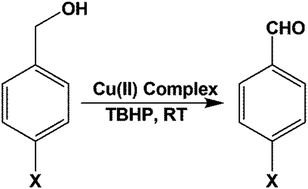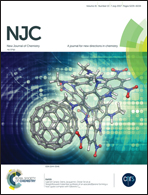Mono-, tri- and polynuclear copper(ii) complexes of Schiff-base ligands: synthesis, characterization and catalytic activity towards alcohol oxidation†
Abstract
Three new copper(II) complexes with different Schiff-base ligands, namely, [Cu(L1)Cl2] (1), [Cu3(L2)2Cl4] (2) and [Cu(L3)N3]n (3) where L1 = 2-morpholino-N-(pyridin-2-ylmethylene)ethanamine, HL2 = 4-bromo-2-((2-morpholinoethylimino)methyl)phenol and HL3 = 4-chloro-2-((2-(dimethylamino)ethylimino)methyl)phenol, have been synthesized and characterized by elemental analysis, standard spectroscopic methods, cyclic voltammometry and single crystal X-ray diffraction analysis. The X-ray diffraction analysis confirms the formation of mononuclear (1), trinuclear (2) and polynuclear (3) complexes. These complexes have been applied as catalysts for alcohol oxidation reactions using tert-butyl hydroperoxide (TBHP) as the terminal oxidant under mild conditions. The catalytic reaction mixture has been analyzed by gas chromatography and it shows that the mononuclear complex has the highest conversion while the other two complexes exhibit moderate catalytic activities. The corresponding aldehyde has been obtained as the sole product. The obtained catalysis results have been corroborated with electrochemical studies.



 Please wait while we load your content...
Please wait while we load your content...